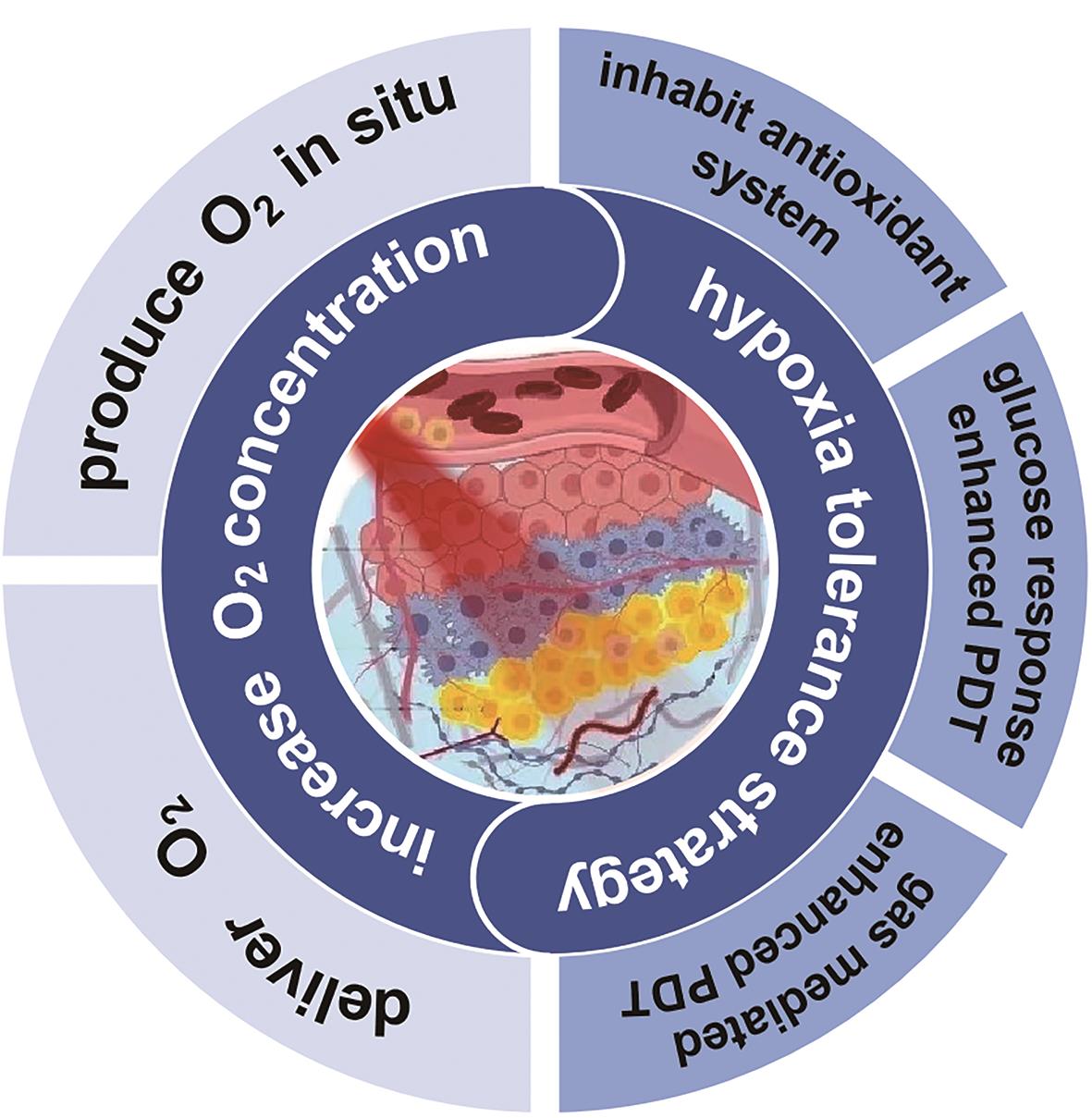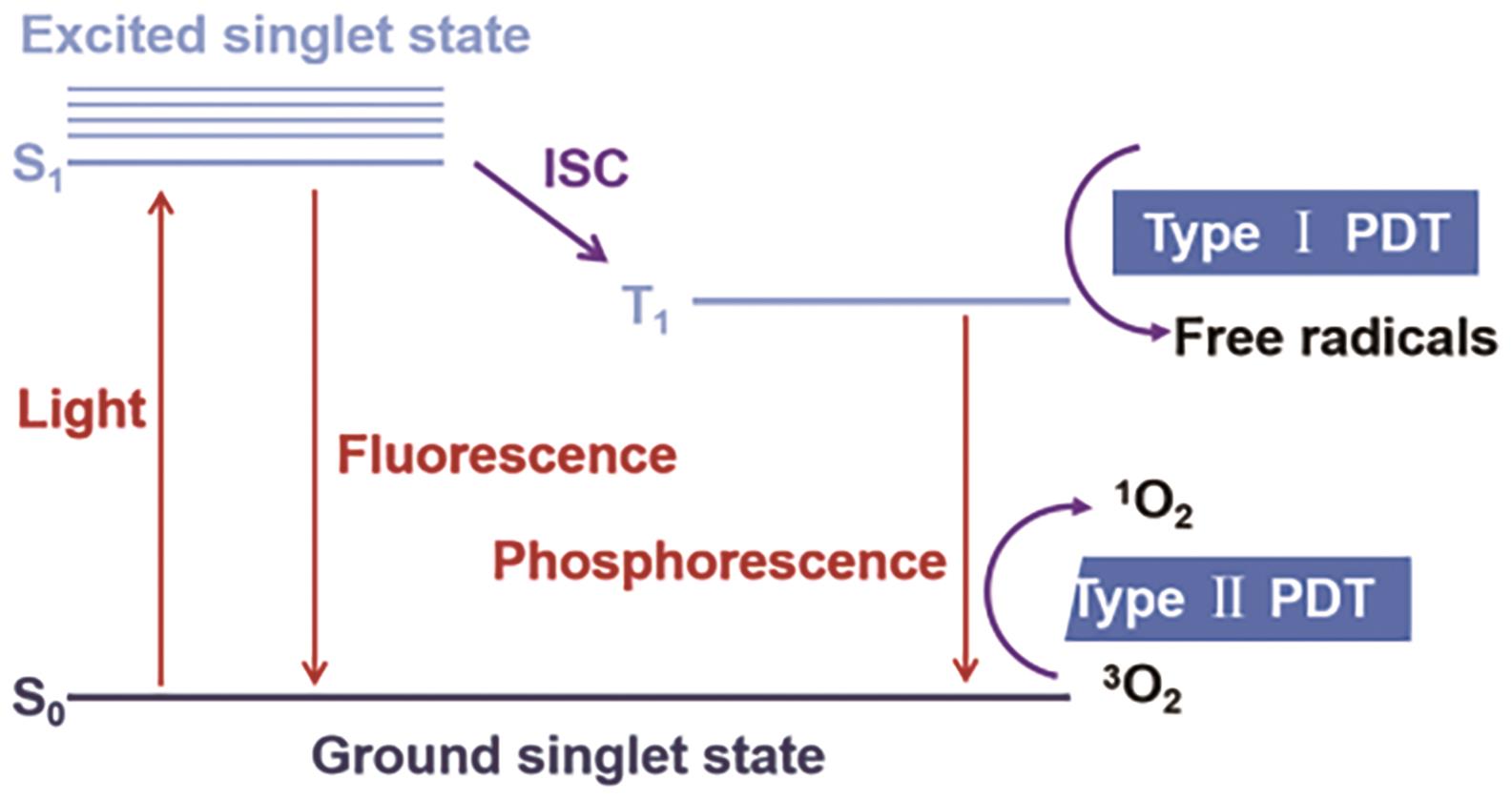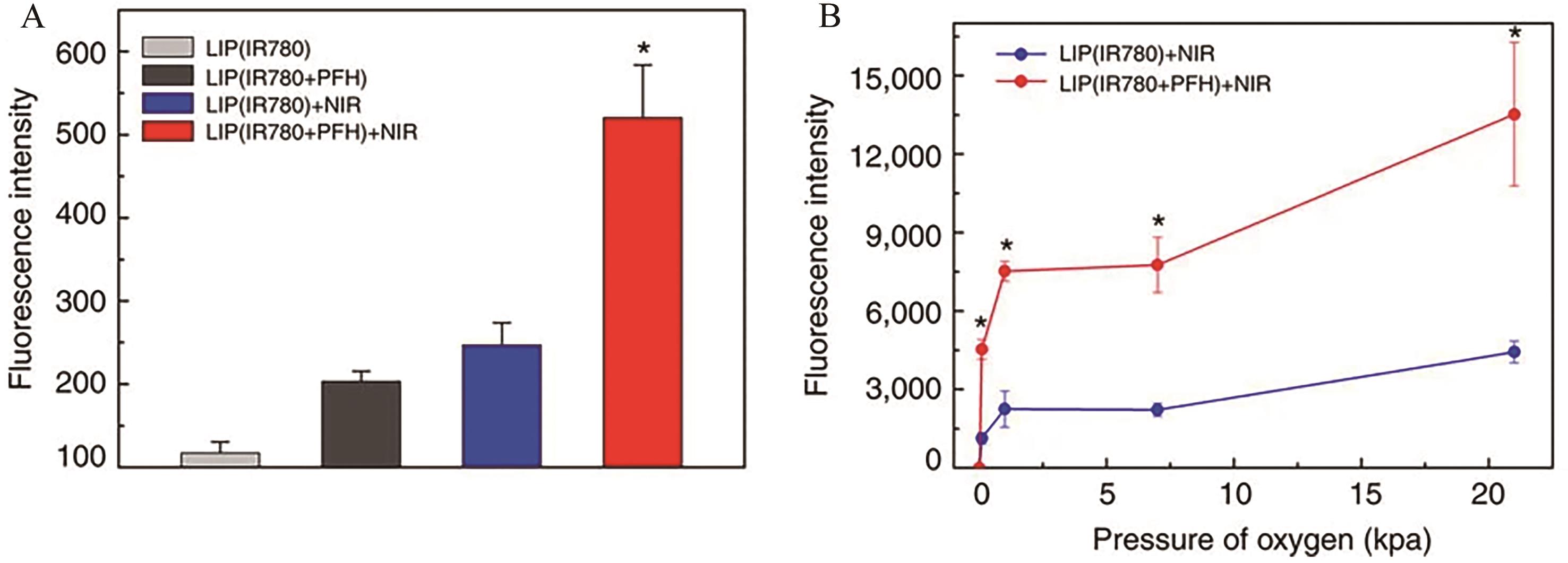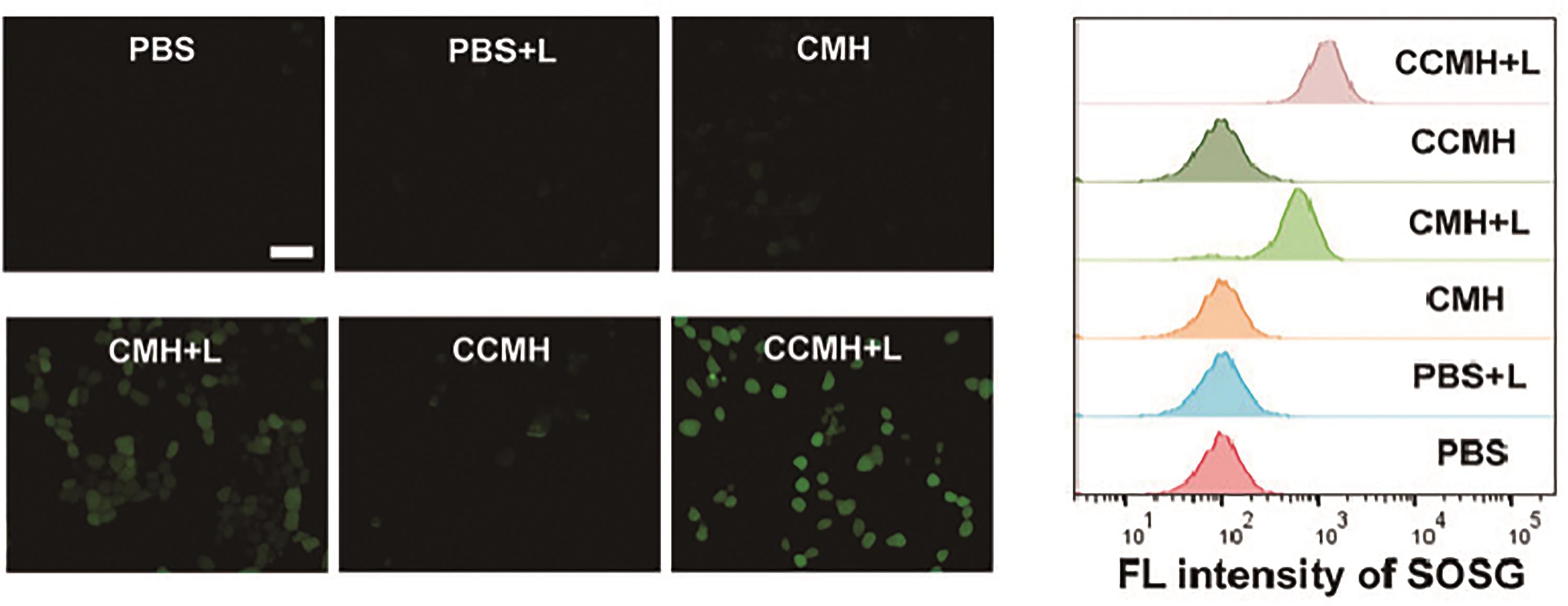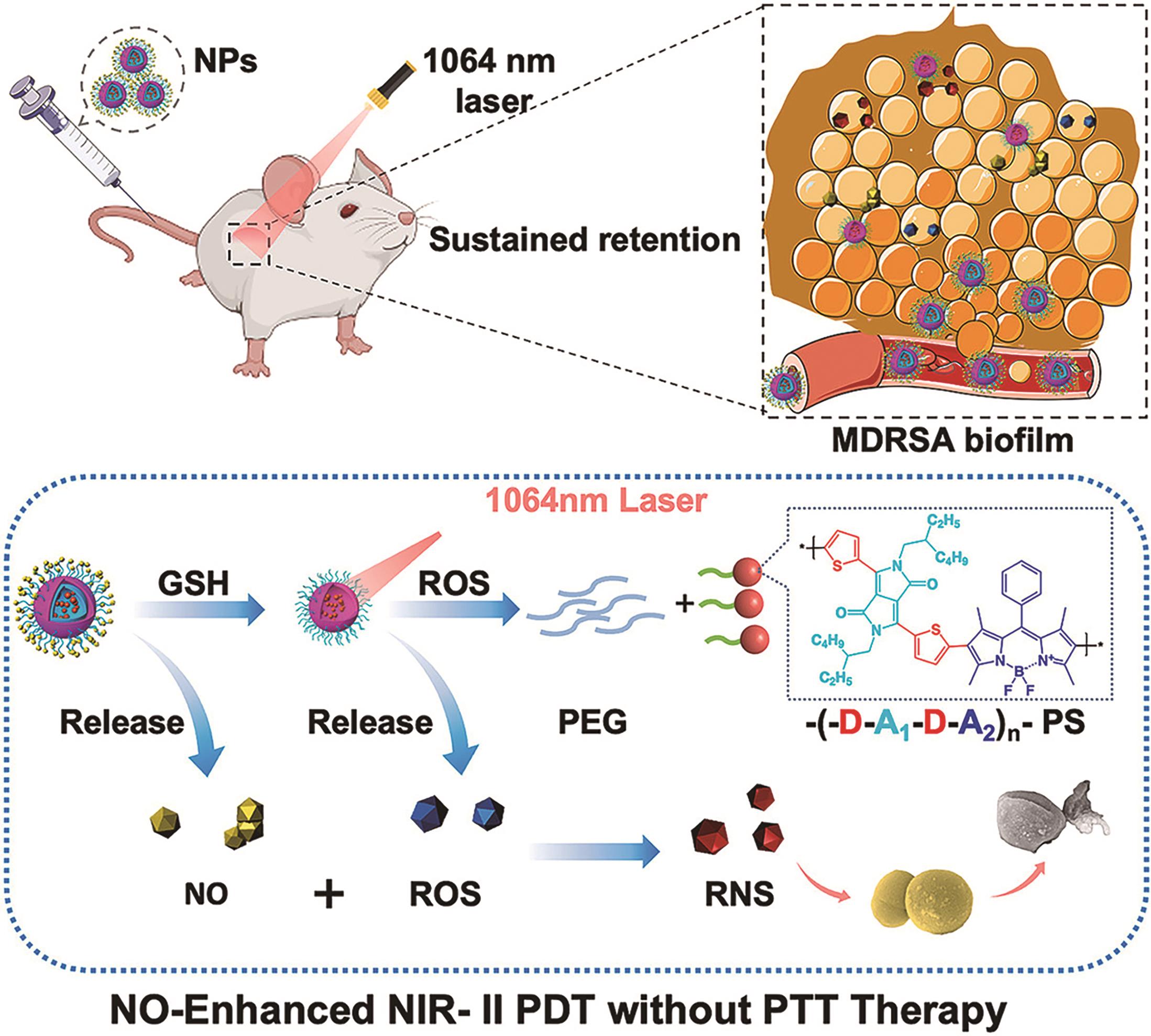
Chinese Journal of Applied Chemistry ›› 2024, Vol. 41 ›› Issue (7): 925-936.DOI: 10.19894/j.issn.1000-0518.240061
• Review • Next Articles
Advances of NIR-Ⅱ-Triggered Photodynamic Therapy in Overcoming Tumor Hypoxia Environment
Yi-Qian YANG1,2,3, Xiao-Xia YAN1( ), Hao PENG2,3(
), Hao PENG2,3( ), Ai-Guo WU2,3, Fang YANG2,3(
), Ai-Guo WU2,3, Fang YANG2,3( )
)
- 1.Department of Chemistry,Shanghai University,Shanghai 200444,China
2.Laboratory of Advanced Theranostic Materials and Technology,Ningbo Institute of Materials Technology and Engineering,Chinese Academy of Sciences,Ningbo 315201,China
3.Advanced Energy Science and Technology Guangdong Laboratory,Huizhou 516000,China
-
Received:2024-02-29Accepted:2024-04-19Published:2024-07-01Online:2024-08-03 -
Contact:Xiao-Xia YAN,Hao PENG,Fang YANG -
About author:yangf@nimte.ac.cn
penghao@nimte.ac.cn
xxyan@shu.edu.cn
-
Supported by:the Youth Innovation Promotion Association, Chinese Academy of Sciences(2022301);Ningbo 3315 Innovative Talent Project(2018-05-G)
CLC Number:
Cite this article
Yi-Qian YANG, Xiao-Xia YAN, Hao PENG, Ai-Guo WU, Fang YANG. Advances of NIR-Ⅱ-Triggered Photodynamic Therapy in Overcoming Tumor Hypoxia Environment[J]. Chinese Journal of Applied Chemistry, 2024, 41(7): 925-936.
share this article
Add to citation manager EndNote|Ris|BibTeX
URL: http://yyhx.ciac.jl.cn/EN/10.19894/j.issn.1000-0518.240061
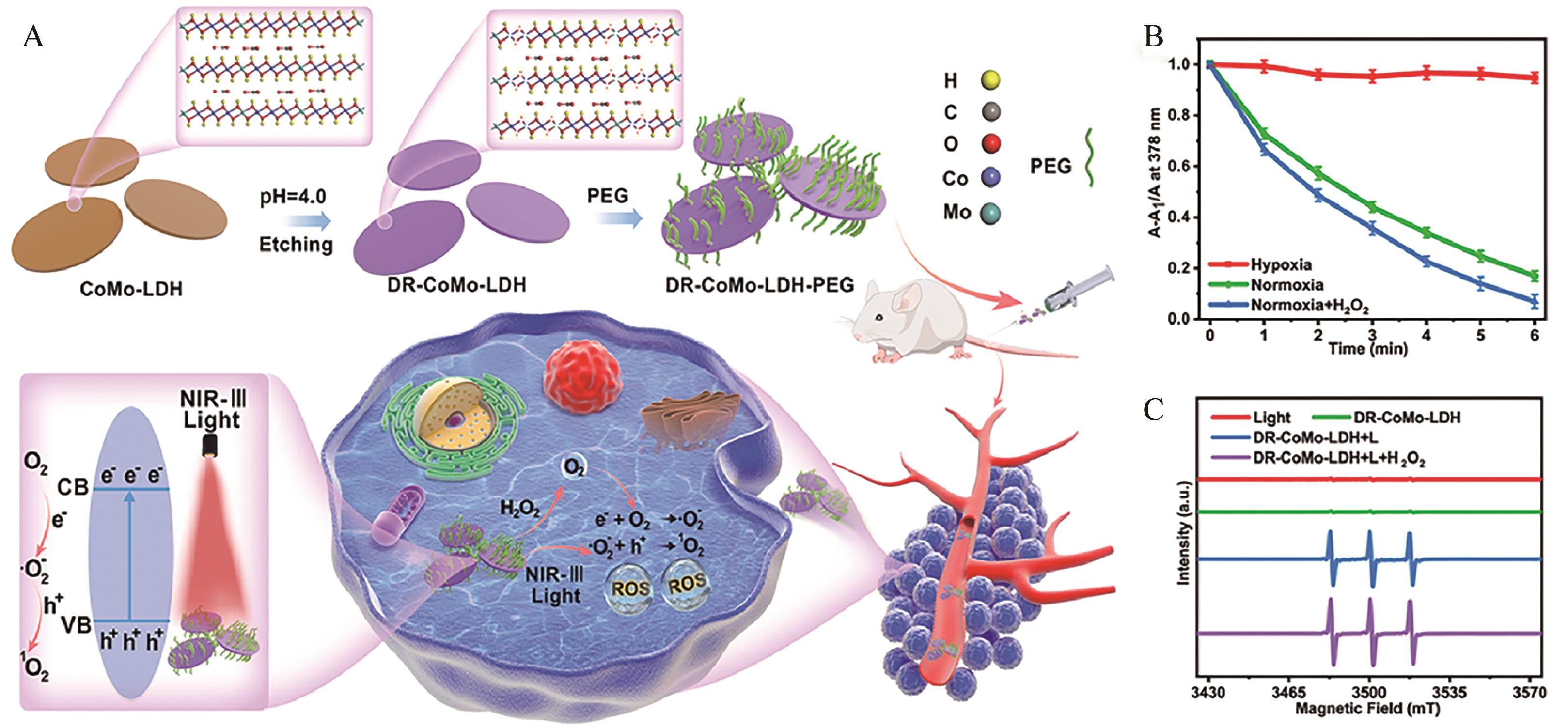
Fig.4 (A) Schematic illustration of the defect engineering of CoMo-LDH nanosheets; Identification of 1O2 generation by measuring the absorbance of ABDA in the presence of the CoMo-LDH nanosheets under different environments (B) and ESR spectra of TEMP for the CoMo-LDH nanosheets in different cases (C)[48]

Fig.6 (A) Schematic illustration of all-in-one nanoplatform containing MnO2/Ag3SbS3; (B) GSH depletion and O2 generation under different treatments[59]
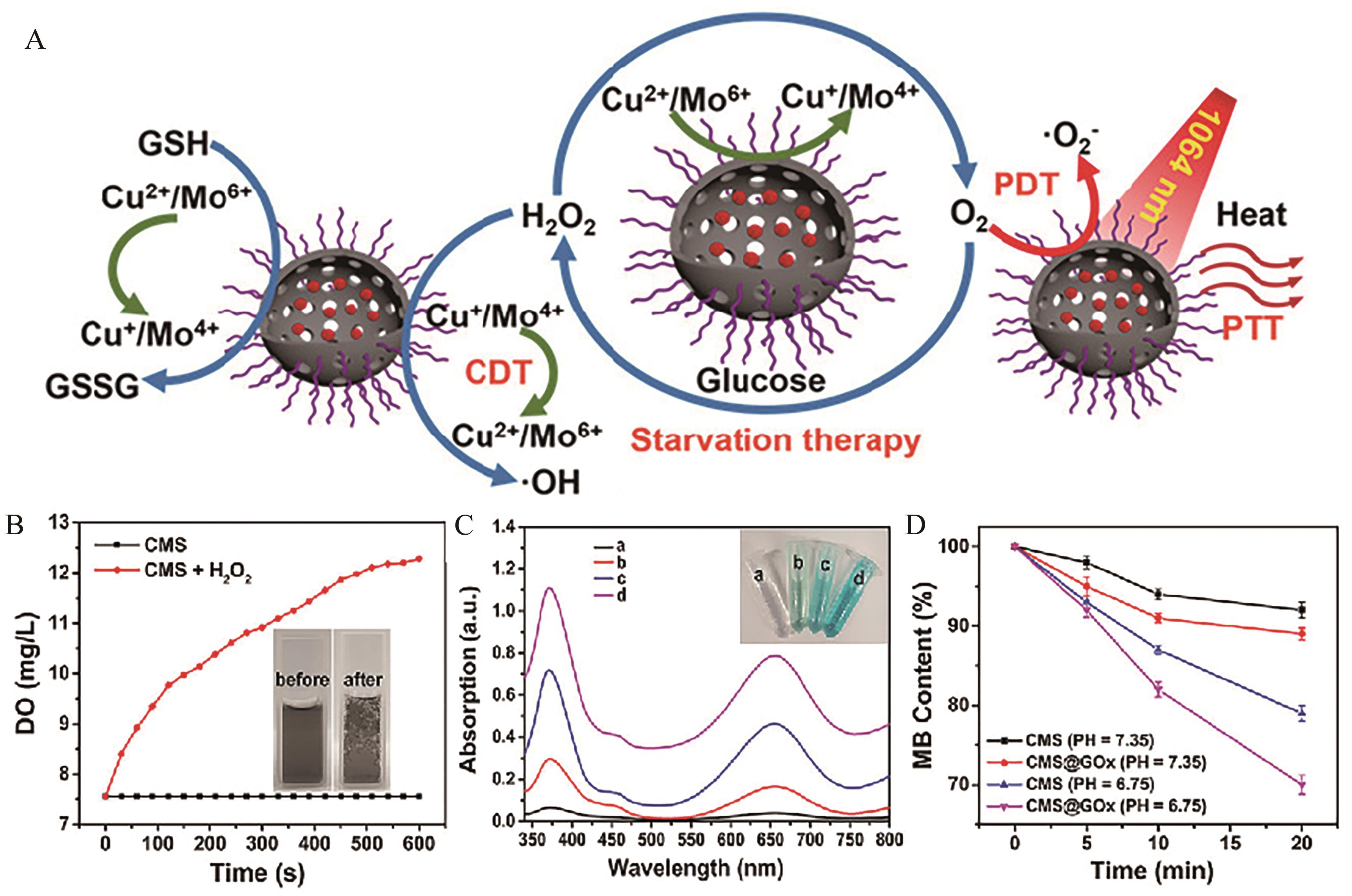
Fig.7 (A) Schematic illustration of mechanism of CMS@GOx for PTT/PDT/CDT/starvation therapy; (B) The generation of dissolved O2 in CMS aqueous solution without and with H2O2 addition; (C) H2O2 generation in CMS@GOx solution arising from the addition of different concentrations of glucose: (a) 0 L, (b) 2×10-3 L, (c) 4×10-3 L, (d) 8×10-3 L; (D) Generation of ·OH over CMS or CMS@GOx under different treatments[65]
| 1 | LIANG X, CHEN M, BHATTARAI P, et al. Complementing cancer photodynamic therapy with ferroptosis through iron oxide loaded porphyrin-grafted lipid nanoparticles[J]. ACS Nano, 2021, 15: 20164-20180. |
| 2 | TAO W, WANG N, RUAN J, et al. Enhanced ROS-boosted phototherapy against pancreatic cancer via Nrf2-mediated stress-defense pathway suppression and ferroptosis induction[J]. ACS Appl Mater Interfaces, 2022, 14: 6404-6416. |
| 3 | HOU H, HUANG X, WEI G, et al. Fenton reaction-assisted photodynamic therapy for cancer with multifunctional magnetic nanoparticles[J]. ACS Appl Mater Interfaces, 2019, 11: 29579-29592. |
| 4 | DAI H, WANG X, SHAO J, et al. NIR-Ⅱ organic nanotheranostics for precision oncotherapy[J]. Small, 2021, 17: e2102646. |
| 5 | XUE E Y, YANG C, FONG W P, et al. Site-specific displacement-driven activation of supramolecular photosensitizing nanoassemblies for antitumoral photodynamic therapy[J]. ACS Appl Mater Interfaces, 2022, 14: 14903-14915. |
| 6 | CUI D, LI J, ZHAO X, PU K, et al. Semiconducting polymer nanoreporters for near-infrared chemiluminescence imaging of immunoactivation[J]. Adv Mater, 2020, 32: e1906314. |
| 7 | XIE J, WANG Y, CHOI W, et al. Overcoming barriers in photodynamic therapy harnessing nano-formulation strategies[J]. Chem Soc Rev, 2021, 50: 9152-9201. |
| 8 | JI B, WEI M, YANG B. Recent advances in nanomedicines for photodynamic therapy (PDT)-driven cancer immunotherapy[J]. Theranostics, 2022, 12: 434-458. |
| 9 | LI X L, JIANG C, JIA X L, et al. Dual “unlocking” strategy to overcome inefficient nanomedicine delivery and tumor hypoxia for enhanced photodynamic-immunotherapy[J]. Adv Healthc Mater, 2023, 12(6): e2202467. |
| 10 | HAN K, ZHANG J, ZHANG W, et al. Tumor-triggered geometrical shape switch of chimeric peptide for enhanced in vivo tumor internalization and photodynamic therapy[J]. ACS Nano, 2017, 11: 3178-3188. |
| 11 | ZHAO X, LIU J, FAN J, et al. Recent progress in photosensitizers for overcoming the challenges of photodynamic therapy: from molecular design to application[J]. Chem Soc Rev, 2021, 50(6): 4185-4219. |
| 12 | FAN W, HUANG P, CHEN X. Overcoming the Achilles' heel of photodynamic therapy[J]. Chem Soc Rev, 2016, 45(23): 6488-6519. |
| 13 | SUN B, BTE RAHMAT J N, ZHANG Y. Advanced techniques for performing photodynamic therapy in deep-seated tissues[J]. Biomaterials, 2022, 291: 121875. |
| 14 | ZHOU Z, SONG J, NIE L, et al. Reactive oxygen species generating systems meeting challenges of photodynamic cancer therapy[J]. Chem Soc Rev, 2016, 45(23): 6597-6626. |
| 15 | HAN K, MA Z, HAN H. Functional peptide-based nanoparticles for photodynamic therapy[J]. J Mater Chem B, 2018, 6: 25-38. |
| 16 | SHI T, HUANG C, LI Y, et al. NIR-Ⅱ phototherapy agents with aggregation-induced emission characteristics for tumor imaging and therapy[J]. Biomaterials, 2022, 285: 121535. |
| 17 | LI X, ZHAO Z, ZHANG M, et al. Research progress of microneedles in the treatment of melanoma[J]. J Control Release, 2022, 348: 631-647. |
| 18 | ZHOU J Y, WANG W J, ZHANG C Y, et al. Ru(Ⅱ)-modified TiO2 nanoparticles for hypoxia-adaptive photo-immunotherapy of oral squamous cell carcinoma[J]. Biomaterials, 2022, 289: 121757. |
| 19 | JIANG Y, ZHAO X, HUANG J, et al. Transformable hybrid semiconducting polymer nanozyme for second near-infrared photothermal ferrotherapy[J]. Nat Commun, 2020, 11: 1857. |
| 20 | QIAN Y, WANG J L, BU W B, et al. Targeted implementation strategies of precise photodynamic therapy based on clinical and technical demands[J]. Biomater Sci, 2023, 11: 704-718. |
| 21 | ZHANG C, HU X, JIN L, et al. Strategic design of conquering hypoxia in tumor for advanced photodynamic therapy[J]. Adv Healthc Mater, 2023, 12(24): e2300530. |
| 22 | GENG B, YAN L, ZHU Y, et al. Carbon dot@MXene nanozymes with triple enzyme-mimic activities for mild NIR-Ⅱ photothermal-amplified nanocatalytic therapy[J]. Adv Healthc Mater, 2023, 12(5): e2202154. |
| 23 | ZHOU Z H, HUANG J S, ZHANG Z Y, et al. Bimetallic PdPt-based nanocatalysts for photothermal-augmented tumor starvation and sonodynamic therapy in NIR-Ⅱ biowindow assisted by an oxygen self-supply strategy[J]. Chem Eng J, 2022, 435(2): 135085. |
| 24 | YANG Y, CHEN M, WANG B, et al. NIR-Ⅱ driven plasmon-enhanced catalysis for a timely supply of oxygen to overcome hypoxia-induced radiotherapy tolerance[J]. Angew Chem Int Ed, 2019, 58: 15069-15075. |
| 25 | LIU Y, JIANG Y, ZHANG M, et al. Modulating hypoxia via nanomaterials chemistry for efficient treatment of solid tumors[J]. Acc Chem Res, 2018, 51(10): 2502-2511. |
| 26 | JIANG L Y, BAI H T, LIU L B, et al. Luminescent, oxygen-supplying, hemoglobin-linked conjugated polymer nanoparticles for photodynamic therapy[J]. Angew Chem Int Ed, 2019, 58: 10660-10665. |
| 27 | ZHANG F, ZHANG B, WANG Y Y, et al. An extra-erythrocyte role of haemoglobin body in chondrocyte hypoxia adaption[J]. Nature, 2023, 622(7984): 834-841. |
| 28 | KIM H, YOON J, KIM H K, et al. Upconverting nanoparticle-containing erythrocyte-sized hemoglobin microgels that generate heat, oxygen and reactive oxygen species for suppressing hypoxic tumors[J]. Bioact Mater, 2023, 22: 112-126. |
| 29 | DING L, WU Y N, WU M, et al. Engineered red blood cell biomimetic nanovesicle with oxygen self-supply for near-infrared-Ⅱ fluorescence-guided synergetic chemo-photodynamic therapy against hypoxic tumors[J]. ACS Appl Mater Interfaces, 2021, 13: 52435-52449. |
| 30 | LIU F R, HE T, GONG S L, et al. A tumor pH-responsive autocatalytic nanoreactor as a H2O2 and O2 self-supplying depot for enhanced ROS-based chemo/photodynamic therapy[J]. Acta Biomater, 2022, 154: 510-522. |
| 31 | WANG H R, GUO Y F, WANG C, et al. Light-controlled oxygen production and collection for sustainable photodynamic therapy in tumor hypoxia[J]. Biomaterials, 2021, 269: 120621. |
| 32 | ZHANG Y F, BO S W, FENG T, et al. A Versatile theranostic nanoemulsion for architecture-dependent multimodal imaging and dually augmented photodynamic therapy[J]. Adv Mater, 2019, 31(21): e1806444. |
| 33 | ZHANG Y F, LIAO Y Y, TANG Q N, et al. Biomimetic nanoemulsion for synergistic photodynamic-immunotherapy against hypoxic breast tumor[J]. Angew Chem Int Ed, 2021, 60: 10647-10653. |
| 34 | ZHANG S, LI Z, WANG Q, et al. An NIR-Ⅱ photothermally triggered “oxygen bomb” for hypoxic tumor programmed cascade therapy[J]. Adv Mater, 2022, 34: e2201978. |
| 35 | CHENG Y H, CHENG H, JIANG C X, et al. Perfluorocarbon nanoparticles enhance reactive oxygen levels and tumour growth inhibition in photodynamic therapy[J]. Nat Commun, 2015, 6: 8785. |
| 36 | WANG W, CHENG Y, YU P, et al. Perfluorocarbon regulates the intratumoural environment to enhance hypoxia-based agent efficacy[J]. Nat Commun, 2019, 10(1): 1580. |
| 37 | NAVYA P N, MEHLA S, BEGUM A, et al. Smart nanozymes for cancer therapy: the next frontier in oncology[J]. Adv Healthc Mater, 2023, 12(25): e2300768. |
| 38 | CHEN X, QIU M J, LIU L P, et al. Intelligent Bi2Se3@Cu2- xSe heterostructures with enhanced photoabsorption and photoconversion efficiency for tri-modal imaging guided combinatorial cancer therapy by near-infrared Ⅱ light[J]. J Colloid Interface Sci, 2022, 625: 614-627. |
| 39 | LIU C, XING J, AKAKURU O U, LUO L J, et al. Nanozymes-engineered metal-organic frameworks for catalytic cascades-enhanced synergistic cancer therapy[J]. Nano Lett, 2019, 19: 5674-5682. |
| 40 | LI Q, WU T T, FAN X W, et al. Multifaceted nanozymes for synergistic antitumor therapy: a review[J]. Mater Des, 2022, 224: 111430. |
| 41 | WANG L M, KANG K K, HOU H Y, et al. NIR-Ⅱ-driven intracellular photocatalytic oxygen-generation on Z-scheme iron sulfide/cobalt sulfide nanosheets for hypoxic tumor therapy[J]. J Colloid Interface Sci, 2022, 625: 145-157. |
| 42 | HUANG Y, REN J, QU X. Nanozymes: classification, catalytic mechanisms, activity regulation, and applications[J]. Chem Rev, 2019, 119(6): 4357-4412. |
| 43 | XU D, WU L, YAO H, et al. Catalase-like nanozymes: classification, catalytic mechanisms, and their applications[J]. Small, 2022, 18(37): e2203400. |
| 44 | ZHANG R, CHEN L, LIANG Q, et al. Unveiling the active sites on ferrihydrite with apparent catalase-like activity for potentiating radiotherapy[J]. Nano Today, 2021, 41: 101317. |
| 45 | ZHU Y, WANG Y J, WILLIAMS G R, et al. Multicomponent transition metal dichalcogenide nanosheets for imaging-guided photothermal and chemodynamic therapy[J]. Adv Sci, 2020, 7(23): 2000272. |
| 46 | YAN L, WANG Y J, HU T T, et al. Layered double hydroxide nanosheets: towards ultrasensitive tumor microenvironment responsive synergistic therapy[J]. J Mater Chem B, 2020, 8: 1445-1455. |
| 47 | HU T T, YAN L, WANG Z D, et al. A pH-responsive ultrathin Cu-based nanoplatform for specific photothermal and chemodynamic synergistic therapy[J]. Chem Sci, 2021, 12: 2594-2603. |
| 48 | SHEN W C, HU T T, LIU X Y, et al. Defect engineering of layered double hydroxide nanosheets as inorganic photosensitizers for NIR-Ⅲ photodynamic cancer therapy[J]. Nat Commun, 2022, 13(1): 3384. |
| 49 | WANG H, ZHAO Y, LI T, et al. Properties of calcium peroxide for release of hydrogen peroxide and oxygen: a kinetics study[J]. Chem Eng J, 2016, 303: 450-457. |
| 50 | RASTINFARD A, NAZARPAK M H, MOZTARZADEH F. Controlled chemical synthesis of CaO2 particles coated with polyethylene glycol: characterization of crystallite size and oxygen release kinetics[J]. RSC Adv, 2018, 8: 91-101. |
| 51 | KHODAVEISI J, BANEJAD H, AFKHAMI A, et al. Synthesis of calcium peroxide nanoparticles as an innovative reagent for in situ chemical oxidation[J]. J Hazard Mater, 2011, 192: 1437-1440. |
| 52 | LI W L, XIN H, ZHANG Y N, et al. NIR-Ⅱ fluorescence imaging-guided oxygen self-sufficient nano-platform for precise enhanced photodynamic therapy[J]. Small, 2022, 18(51): e2205647. |
| 53 | XIAO Y P, LI Z, BIANCO A, et al. Recent advances in calcium-based anticancer nanomaterials exploiting calcium overload to trigger cell apoptosis[J]. Adv Funct Mater, 2022, 33(3): 2209291. |
| 54 | HUANG C, LIN B Q, CHEN C Y, et al. Synergistic reinforcing of immunogenic cell death and transforming tumor-associated macrophages via a multifunctional cascade bioreactor for optimizing cancer immunotherapy[J]. Adv Mater, 2022, 34(51): e2207593. |
| 55 | YANG B, ZHANG Y, SUN L, et al. Modulated ultrasmall γ-Fe2O3 nanocrystal assemblies for switchable magnetic resonance imaging and photothermal-ferroptotic-chemical synergistic cancer therapy[J]. Adv Funct Mater, 2022, 33(5): 2211251. |
| 56 | XIONG H, WANG C, WANG Z, et al. Intracellular cascade activated nanosystem for improving ER+ breast cancer therapy through attacking GSH-mediated metabolic vulnerability[J]. J Control Release, 2019, 309: 145-157. |
| 57 | XU W, WANG T, QIAN J, et al. Fe(Ⅱ)-hydrazide coordinated all-active metal organic framework for photothermally enhanced tumor penetration and ferroptosis-apoptosis synergistic therapy[J]. Chem Eng J, 2022, 437:135311. |
| 58 | YANG Y, WANG P, SHI R, et al. Design of the tumor microenvironment-multiresponsive nanoplatform for dual-targeting and photothermal imaging guided photothermal/photodynamic/chemodynamic cancer therapies with hypoxia improvement and GSH depletion[J]. Chem Eng J, 2022, 441: 136042. |
| 59 | WANG Q, QU B T, LI J, et al. Multifunctional MnO2/Ag3SbS3 nanotheranostic agent for single-laser-triggered tumor synergistic therapy in the NIR-Ⅱ biowindow[J]. ACS Appl Mater Interfaces, 2022, 14: 4980-4994. |
| 60 | WANG Y, LI Y, ZHANG Z, et al. Triple-jump photodynamic theranostics: MnO2 combined upconversion nanoplatforms involving a type-Ⅰ photosensitizer with aggregation-induced emission characteristics for potent cancer treatment[J]. Adv Mater, 2021, 33(41): e2103748. |
| 61 | HAO H J, SUN M M, LI P Y, et al. In situ growth of a cationic polymer from the N-terminus of glucose oxidase to regulate H2O2 generation for cancer starvation and H2O2 therapy[J]. ACS Appl Mater Interfaces, 2019, 11: 9756-9762. |
| 62 | ZHANG H W, LU F, PAN W, et al. A dual-catalytic nanoreactor for synergistic chemodynamic-starvation therapy toward tumor metastasis suppression[J]. Biomater Sci, 2021, 9: 3814-3820. |
| 63 | YU Z Z, ZHOU P, PAN W, et al. A biomimetic nanoreactor for synergistic chemiexcited photodynamic therapy and starvation therapy against tumor metastasis[J]. Nat Commun, 2018, 9(1): 5044. |
| 64 | WU J Y Z, ZHANG Y F, JIANG K J, et al. Enzyme-engineered conjugated polymer nanoplatform for activatable companion diagnostics and multistage augmented synergistic therapy[J]. Adv Mater, 2022, 34(18): e2200062. |
| 65 | CHANG M, WANG M, WANG M, et al. A multifunctional cascade bioreactor based on hollow-structured Cu2MoS4 for synergetic cancer chemo-dynamic therapy/starvation therapy/phototherapy/immunotherapy with remarkably enhanced efficacy[J]. Adv Mater, 2019, 31: e1905271. |
| 66 | LV Z J, JIN L H, GAO W H, et al. Novel YOF-based theranostic agents with a cascade effect for NIR-Ⅱ fluorescence imaging and synergistic starvation/photodynamic therapy of orthotopic gliomas[J]. ACS Appl Mater Interfaces, 2022, 14: 30523-30532. |
| 67 | GAO X, FENG J, SONG S Y, et al. Tumor-targeted biocatalyst with self-accelerated cascade reactions for enhanced synergistic starvation and photodynamic therapy[J]. Nano Today, 2022, 43: 101433. |
| 68 | LI X L, JIANG C, WANG Q H, et al. A “valve-closing” starvation strategy for amplification of tumor-specific chemotherapy[J]. Adv Sci, 2022, 9(8): e2104671. |
| 69 | SZABO C. Gasotransmitters in cancer: from pathophysiology to experimental therapy[J]. Nat Rev Drug Discov, 2016, 15: 185-203. |
| 70 | WANG Y S, YANG T, HE Q J. Strategies for engineering advanced nanomedicines for gas therapy of cancer[J]. Natl Sci Rev, 2020, 7: 1485-1512. |
| 71 | WANG K Y, LI Y, WANG X, et al. Gas therapy potentiates aggregation-induced emission luminogen-based photoimmunotherapy of poorly immunogenic tumors through cGAS-STING pathway activation[J]. Nat Commun, 2023, 14(1): 2950. |
| 72 | JI P, YANG K X, XU Q Q, et al. Mechanisms and application of gas-based anticancer therapies[J]. Pharmaceuticals-Base, 2023, 16(10): 1394. |
| 73 | JIANG J, XIE J, ZHOU L, et al. Near infrared responsive nitric oxide and carbon monoxide nanoplatform for synergistic photodynamic therapy against periodontitis[J]. Chem Eng J, 2024, 480: 147850. |
| 74 | CHANG M, WANG M, LIU Y, et al. Dendritic plasmonic CuPt alloys for closed-loop multimude cancer therapy with remarkably enhanced efficacy[J]. Small, 2022, 19: e2206423. |
| 75 | LUO G H, LI Z H, CHEN M L, et al. Three-staged tumor inhibition by mitochondria-targeted cascaded gas/mild-photothermal/photodynamic synergistic therapy[J]. Chem Eng J, 2022, 442: 136169. |
| 76 | LIU F R, GONG S L, SHEN M L, et al. A glutathione-activatable nanoplatform for enhanced photodynamic therapy with simultaneous hypoxia relief and glutathione depletion[J]. Chem Eng J, 2021, 403: 126305. |
| 77 | LI M, ZHAO M, ZHANG Y J, et al. Second near-infrared light-activated semiconducting polymer nanomediators enable three-in-one tumor microenvironment modulation for combination immunotherapy[J]. Nano Today, 2023, 50: 101833. |
| 78 | BU F Q, KANG X X, TANG D S, et al. Enhancing near-infrared Ⅱ photodynamic therapy with nitric oxide for eradicating multidrug-resistant biofilms in deep tissues[J]. Bioact Mater, 2024, 33: 341-354. |
| 79 | WANG Z X, ZHAN M X, LI W J, et al. Photoacoustic cavitation-ignited reactive oxygen species to amplify peroxynitrite burst by photosensitization-free polymeric nanocapsules[J]. Angew Chem Int Ed, 2021, 60: 4720-4731. |
| 80 | WANG R, XIA X, YANG Y J, et al. A glutathione activatable photosensitizer for combined photodynamic and gas therapy under red light irradiation[J]. Adv Healthc Mater, 2022, 11(4): e2102017. |
| 81 | ZHANG T F, PAN Y, SUO M, et al. Photothermal-triggered sulfur oxide gas therapy augments type Ⅰ photodynamic therapy for potentiating cancer stem cell ablation and inhibiting radioresistant tumor recurrence[J]. Adv Sci, 2023, 10(29): e2304042. |
| 82 | ZHANG Y, SHEN W, ZHANG P, et al. GSH-triggered release of sulfur dioxide gas to regulate redox balance for enhanced photodynamic therapy[J]. Chem Commun, 2020, 56: 5645-5648. |
| 83 | LIU Z, FENG Z, CHEN M, et al. An orthogonally activatable CRISPR-Cas13d nanoprodrug to reverse chemoresistance for enhanced chemo-photodynamic therapy[J]. Chem Sci, 2023, 14: 4102-4113. |
| 84 | CHAI X, YI D, SHENG C, et al. A remotely controlled nanosystem for spatiotemporally specific gene regulation and combinational tumor therapy[J]. Angew Chem Int Ed, 2023, 62: e202217702. |
| 85 | LI Q, FAN H, XU Y, et al. NIR-responsive hollow germanium nanospheres mediate photothermal/photodynamic therapy and restrain immunosuppression to cooperatively eradicate primary and metastatic tumors[J]. Chem Eng J, 2023, 458: 141314. |
| 86 | WAN G, CHEN X, CHEN J, et al. Endoplasmic reticulum-targeted NIR-Ⅱ phototherapy combined with inflammatory vascular suppression elicits a synergistic effect against TNBC[J]. Biomater Sci, 2023, 11: 1876-1894. |
| [1] | Ying-Wei LI, Ji HAN, Bu-Yuan GUAN. Research Progress on the Synthesis and Application of Two-Dimensional Mesoporous Materials [J]. Chinese Journal of Applied Chemistry, 2024, 41(6): 767-782. |
| [2] | Kong-Hao PENG, An-Qi BAI, Ying MENG, Hui YIN, Xin-Yao SU, Jin-Yu YANG, Shu-Rong LI, Ling-Yan ZHANG, Li-Xia LUO, Pei-Jun MENG. Research Progress of Nanomaterial Sensors in the Detection of Organophosphorus Pesticide Residues [J]. Chinese Journal of Applied Chemistry, 2024, 41(4): 472-483. |
| [3] | Na YIN, Ying-Hui WANG, Hong-Jie ZHANG. Applications of Rare Earth-Based Nanoparticles in Brain Tumors [J]. Chinese Journal of Applied Chemistry, 2024, 41(3): 309-327. |
| [4] | Hui-Hui LI, Kai-Sheng YAO, Ya-Nan ZHAO, Li-Na FAN, Yu-Lin TIAN, Wei-Wei LU. Ionic Liquid-Modulated Synthesis of Pt-Pd Bimetallic Nanomaterials and Their Catalytic Performance for Ammonia Borane Hydrolysis to Generate Hydrogen [J]. Chinese Journal of Applied Chemistry, 2023, 40(4): 597-609. |
| [5] | Xiao-Hu LIU, Xiao-Juan LAI, Hong-Yan CAO, Ting-Ting WANG, Zhi-Qiang DANG. Synergistic Performance of Foaming Agent/Stabilizer/SiO2 Composite Foam Retarded Acid System [J]. Chinese Journal of Applied Chemistry, 2023, 40(1): 91-99. |
| [6] | Song-Tao ZHANG, Ying-Hui WANG, Hong-Jie ZHANG. Nd3+ Sensitized Fluorescent Nanoprobes for Vascular Imaging in the Second Near Infrared Window [J]. Chinese Journal of Applied Chemistry, 2022, 39(4): 685-693. |
| [7] | Hui DU, Chen-Yang YAO, Hao PENG, Bo JIANG, Shun-Xiang LI, Jun-Lie YAO, Fang ZHENG, Fang YANG, Ai-Guo WU. Applications of Transition Metal⁃doped Iron⁃based Nanoparticles in Biomedicine [J]. Chinese Journal of Applied Chemistry, 2022, 39(3): 391-406. |
| [8] | HUANG Xiao-Tong, CHEN Ying-Xin, ZHU Ze-Bin, ZHOU Li-Hua. Research Progress on Detection of Ascorbic Acid by Nanomaterial-Based Spectral Analysis Method [J]. Chinese Journal of Applied Chemistry, 2021, 38(6): 637-650. |
| [9] | LIU Jiao, ZOU Peng-Fei, LI Ping, ZHANG Xiao, WANG Xin-Xin, GAO Yuan-Yuan, LI Li-Li. Research Progress of the Peptide-Based Self-assembled Nanomaterials Against Microbial Resistance [J]. Chinese Journal of Applied Chemistry, 2021, 38(5): 546-558. |
| [10] | ZHOU Ying, LIU Sai-Nan, CAI Li-Han, ZHANG Jian-Fu, PANG Mao-Lin. Ion-doped Poly(2-nitro-1,4-phenylenediamine) Nanospheres for Synergistic Photo- and Chemo-Dynamic Therapy [J]. Chinese Journal of Applied Chemistry, 2021, 38(2): 0-0. |
| [11] | ZHOU Ying, LIU Sai-Nan, CAI Li-Han, ZHANG Jian-Fu, PANG Mao-Lin. Ion-doped Poly(2-nitro-1,4-phenylenediamine) Nanospheres for Synergistic Photo- and Chemo-Dynamic Therapy [J]. Chinese Journal of Applied Chemistry, 2021, 38(2): 181-187. |
| [12] | LIU Lin-Chang, GUO Ya-Jun, ZHU Hong-Lin, MA Jing-Jing, LI Zhong-Yi, SHUI Miao, ZHENG Yue-Qing. Research Progress on Supported Ultrafine Nano-catalysts for Hydrolytic Dehydrogenation of Ammonia Borane [J]. Chinese Journal of Applied Chemistry, 2021, 38(11): 1405-1422. |
| [13] | MENG Yang, YANG Chan, PENG Juan. Progress in Iron, Cobalt and Nickel-Based Metal Phosphide Nano-catalysts for Hydrogen Production under Alkaline Conditions [J]. Chinese Journal of Applied Chemistry, 2020, 37(7): 733-745. |
| [14] | FAN Zhe,ZHANG Shengsheng,TANG Jiahao,FAN Ping. Structure, Preparation and Application of Graded Nanomaterials [J]. Chinese Journal of Applied Chemistry, 2020, 37(5): 489-501. |
| [15] | WANG Chunli,SUN Lianshan,ZHONG Ming,WANG Limin,CHENG Yong. Research Progress of Transition Metal and Compounds for Lithium-Sulfur Batteries [J]. Chinese Journal of Applied Chemistry, 2020, 37(4): 387-404. |
| Viewed | ||||||
|
Full text |
|
|||||
|
Abstract |
|
|||||
